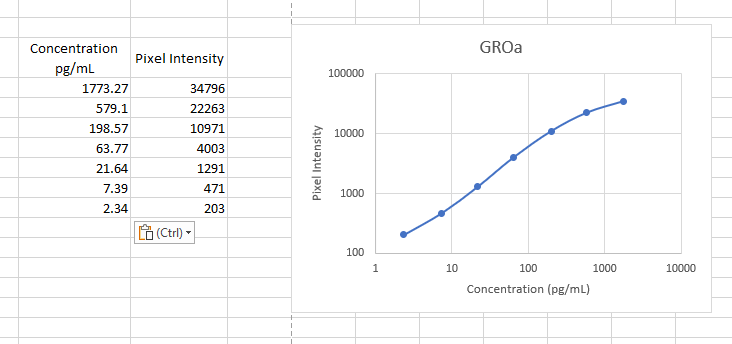Human CXCL1/GRO alpha /KC/CINC-1 Antibody Summary
Ala35-Asn107
Accession # P09341
Applications
Please Note: Optimal dilutions should be determined by each laboratory for each application. General Protocols are available in the Technical Information section on our website.
Scientific Data
 View Larger
View Larger
Detection of Recombinant Human CXCL1/GRO alpha /KC/CINC‑1 by Western Blot. Western blot shows 25 ng of Recombinant Human CXCL1/GROa/KC/CINC-1 (Catalog # 275-GR), Recombinant Mouse CXCL1/GROa/KC/CINC-1 aa 20-96 (Catalog # 453-KC), Recombinant Rat CXCL1/GROa/KC/CINC-1 (Catalog # 515-CN), Recombinant Human CXCL2/GRO beta /MIP-2/CINC-3 aa 35-107 (Catalog # 276-GB), Recombinant Human CXCL3/GRO gamma/CINC-2/DCIP-1 (Catalog # 277-GG), Recombinant Human CXCL7/NAP-2 (Catalog # 393-NP), and Recombinant Human CXCL4/PF4 (Catalog # 795-P4). PVDF Membrane was probed with 0.1 µg/mL of Goat Anti-Human CXCL1/GROa/KC/CINC-1 Antigen Affinity-purified Polyclonal Antibody (Catalog # AF275) followed by HRP-conjugated Anti-Goat IgG Secondary Antibody (Catalog # HAF109). A specific band was detected for CXCL1/GROa/KC/CINC-1 at approximately 11 kDa (as indicated). This experiment was conducted under reducing conditions and using Immunoblot Buffer Group 3.
 View Larger
View Larger
Chemotaxis Induced by CXCL1/GRO alpha and Neutralization by Human CXCL1/GRO alpha Antibody. Recombinant Human CXCL1/GROa (Catalog # 275-GR) chemoattracts the BaF3 mouse pro-B cell line transfected with human CXCR2 in a dose-dependent manner (orange line). The amount of cells that migrated through to the lower chemotaxis chamber was measured by Resazurin (Catalog # AR002). Chemotaxis elicited by Recombinant Human CXCL1/GROa (0.01 µg/mL) is neutralized (green line) by increasing concentrations of Human CXCL1/GROa Antigen Affinity-purified Polyclonal Antibody (Catalog # AF275). The ND50 is typically 0.03-0.15 µg/mL.
Preparation and Storage
- 12 months from date of receipt, -20 to -70 °C as supplied.
- 1 month, 2 to 8 °C under sterile conditions after reconstitution.
- 6 months, -20 to -70 °C under sterile conditions after reconstitution.
Background: CXCL1/GRO alpha/KC/CINC-1
The gene for CXCL1/GRO alpha was initially discovered in hamster cells, using subtractive hybridization techniques, as a message that is over-expressed in tumorigenic cells and in normal cells during growth stimulation. The hamster cDNA was cloned and used as a probe for the subsequent cloning of the human GRO cDNA. Independently, a cDNA encoding a secreted protein with melanoma growth stimulating activity (MGSA) was also cloned from a human melanoma cell line and found to be identical to GRO. In addition to the initially cloned GRO gene, now designated CXCL1, two additional GRO genes, GRO beta or MIP-2 alpha and GRO gamma or MIP‑2 beta, which shared 90% and 86% amino acid sequence homology, respectively, with CXCL1, have been identified. All three human GROs are members of the alpha (C-X-C) subfamily of chemokines. The three GRO cDNAs encode 107 amino acid precursor proteins from which the N-terminal 34 amino acid residues are cleaved to generate the mature GROs. There are no potential N-linked glycosylation sites in the amino acid sequences. GRO expression is inducible by serum or PDGF and/or by a variety of inflammatory mediators, such as IL-1 and TNF, in monocytes, fibroblasts, melanocytes, and epithelial cells. In certain tumor cell lines, GRO is expressed constitutively. Similar to other alpha chemokines, the three GRO proteins are potent neutrophil attractants and activators. In addition, these chemokines are also active toward basophils. All three GROs can bind with high affinity to the IL-8 receptor type B. The rat homolog of human CXCL1, CINC, is much more active than human CXCL1 on rat neutrophils, suggesting that this cytokine may have selective species specificity.
Product Datasheets
Citations for Human CXCL1/GRO alpha /KC/CINC-1 Antibody
R&D Systems personnel manually curate a database that contains references using R&D Systems products. The data collected includes not only links to publications in PubMed, but also provides information about sample types, species, and experimental conditions.
3
Citations: Showing 1 - 3
Filter your results:
Filter by:
-
The C-X-C Motif Chemokine Ligand 1 Sustains Breast Cancer Stem Cell Self-Renewal and Promotes Tumor Progression and Immune Escape Programs
Authors: Stefania Livia Ciummo, Luigi D’Antonio, Carlo Sorrentino, Cristiano Fieni, Paola Lanuti, Giorgio Stassi et al.
Frontiers in Cell and Developmental Biology
Species: Human
Sample Types: Whole Cells, Whole Tissue
Applications: Immunohistochemistry, Neutralization, Immunocytochemistry -
PKM2 promotes metastasis by recruiting myeloid-derived suppressor cells and indicates poor prognosis for hepatocellular carcinoma
Authors: Wei-Ren Liu, Meng-Xin Tian, Liu-Xiao Yang, Yu-Li Lin, Lei Jin, Zhen-Bin Ding et al.
Oncotarget
-
Imbalance in the expression of CXC chemokines correlates with bronchoalveolar lavage fluid angiogenic activity and procollagen levels in acute respiratory distress syndrome.
Authors: Keane MP, Donnelly SC, Belperio JA, Goodman RB, Dy M, Burdick MD, Fishbein MC, Strieter RM
J. Immunol., 2002-12-01;169(11):6515-21.
Species: Human
Sample Types: BALF, Whole Tissue
Applications: ELISA Development, IHC-P
FAQs
No product specific FAQs exist for this product, however you may
View all Antibody FAQsReviews for Human CXCL1/GRO alpha /KC/CINC-1 Antibody
Average Rating: 4.5 (Based on 4 Reviews)
Have you used Human CXCL1/GRO alpha /KC/CINC-1 Antibody?
Submit a review and receive an Amazon gift card.
$25/€18/£15/$25CAN/¥75 Yuan/¥2500 Yen for a review with an image
$10/€7/£6/$10 CAD/¥70 Yuan/¥1110 Yen for a review without an image
Filter by:





